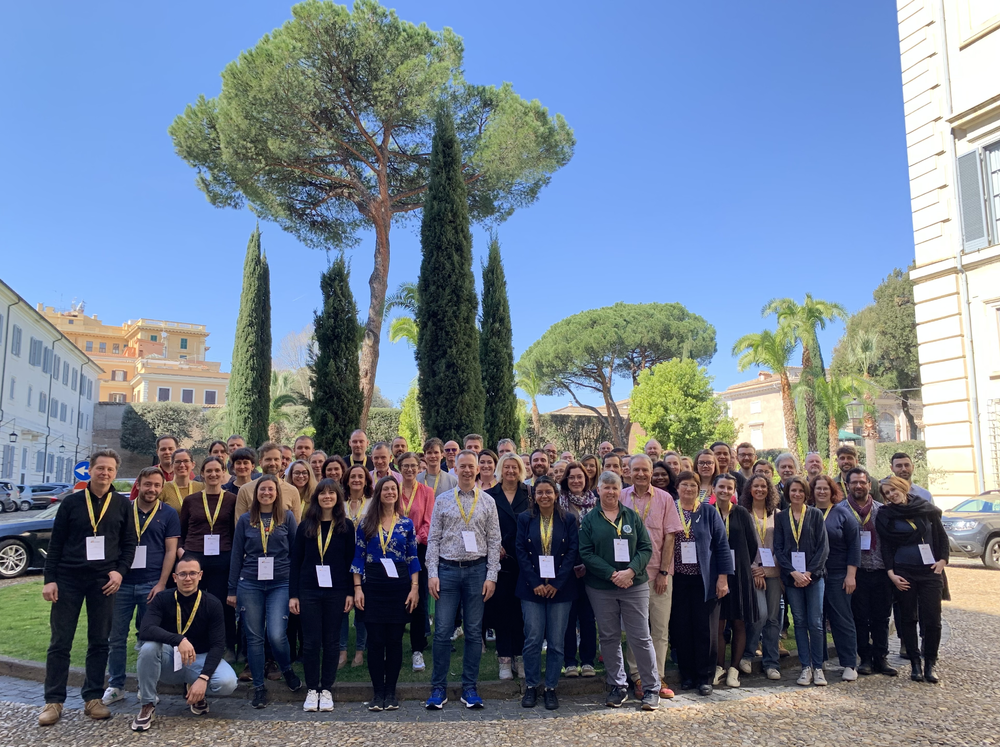pan-european assessment, monitoring, and mitigation of stressors on the health of bees
PoshBee final meeting: wrapping up five years of bee health research
On 22 and 23 March 2023, five years after PoshBee’s kick-off meeting in Paris, project partners and stakeholder advisory committee members gathered for a bitter-sweet final meeting in Rome. It is fair to say that after two online annual meetings, partners were more than happy to gather in person and create that PoshBee buzz in the room one final time.

PoshBee partners at the final meeting in Rome, Italy.
Hosted by project partner Coldiretti, the meeting was officially opened by PoshBee’s project officer Tatiana Tallarico (REA) who pointed out that the project has not only been successful in achieving the targets set out in its funding call but even more so, how useful our results will be to identify topics for future projects supporting healthy bees. And on that note, the rest of the meeting was dedicated to each work package presenting its latest and greatest results. Here is just a small sample of the overwhelming amount of results:
WP1 established a pan-European field site network comprising a total of 128 sites, with sentinel colonies of honey, bumble and red mason bees deployed. Overall, their results support the importance of preserving non-crop habitats and floral resources in agricultural landscapes, particularly in those containing mass-flowering crops. Find out more here.
WP2 presented easy-to-use APISH sensors to robustly detect low levels of several pesticides. WP2 also demonstrated accumulating effects of multiple pressures on the performance of Apis mellifera, Bombus terrestris and Osmia bicornis. In addition, WP2 analysed 320 beebread samples and discovered 98% had pesticide residues (more here).
WP3 presented results with suggestions for improving pesticide regulations and risk assessment. They discovered large variations in degradation rates and sensitivity across bumble bees, solitary bees, and honey bees, and across different castes and sexes (more here). Additionally, WP3 suggested that regulatory tests should address testing of a large range of concentrations, especially low ones, to fully inform pesticide risk assessment (more here and here).
WP4 aimed to develop two representative model ground-nesting wild bee species for risk assessment – Anthophora plumipes and Colletes hederae. They performed for the first time a controlled experiment on A. plumipes testing agrochemical exposure through soil. WP4 also presented a new exposure protocol adapted for wild bees revealing varying sensitivity to sulfoxaflor in European wild bee species. You can find out more about their results in several upcoming publications!
WP5 presented their results on the importance of diverse floral resources for bee development and low pesticide exposure. WP5 found (i) different nutritional needs across bee species; (ii) influence of pollen quality on honey bees' ability to metabolise pesticides and withstand their detrimental effects; (iii) reduction in the volume of ingested sugar solution by mason bees after exposure to sulfoxaflor. More about their results here and here.
WP6 found that the interaction between agrochemicals and bee pathogens is individual (negative, positive; additive or synergistic) and specific to the chemical, pathogen and bee species. Sulfoxaflor increased honey bee mortality and Varroa destructor reproduction. Azoxystrobin in combination with American Foulbrood increased honey bee larval mortality. Sulfoxaflor-Nosema ceranae interaction altered physiology and mortality in honey bees. Exposure of bumble bees to glyphosate and Crithidia bombi had no significant impact. Neither did Crithidia mellificae and flupyradifurone on Osmia bicornis. More about their results here, with a number of publications in preparation.
WP7 presented the results from their semi-field and field experiments. Closer and Amistar showed no major impacts on O.bicornis and A.mellifera but had negative impacts on B.terrestris. Sivanto and nutritional stress had synergistic negative impacts on O.bicornis. WP7 also presented the effects of Amistar and plant species identity on foraging and pollination services of bumble bees. Find out more about their results here.
WP8 shared their conceptualisation of bee health as a hierarchical set of interdependent homeostatic layers, protecting bees; within them, several major dimensions key to health; for each dimension, key indicators to measure its health status at any one time. WP8 also presented the new Bombus model, grounded in the biology of bumble bees, which allows for a deeper understanding of eusocial bumble bees generally as well as landscape-scale risk assessment of bee health. You will be able to learn more about the model in a publication soon!
WP9 presented (i) a hemolymph (‘blood’) test to follow the impact of stressors through molecular mass fingerprints; (ii) bottom-up proteomics workflow (blood/organs) to decipher physiological pathways; and (iii) MALDI imaging mass spectrometry to scan molecules within organs. Find out more about their results here, here and here.
WP10 presented their work on synthesising evidence in an accessible manner to enable knowledge exchange and generate impact. Stay tuned for their upcoming publication carrying out a horizon scan of issues affecting pollinators in agricultural systems.
After hearing about the substantial amount of great project results, PoshBee’s coordinator Prof Mark Brown closed the final meeting. He thanked all partners and stakeholders and highlighted the value of collaborating with people that not only support you but also challenge you, which ultimately led to results with actual impact in contributing to a world with sustainable pollination!